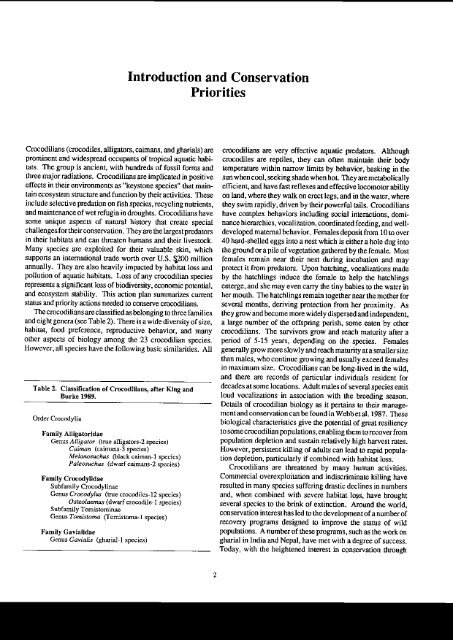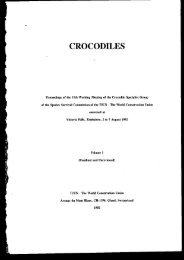size: 7451KB - Crocodile Specialist Group
size: 7451KB - Crocodile Specialist Group
size: 7451KB - Crocodile Specialist Group
Create successful ePaper yourself
Turn your PDF publications into a flip-book with our unique Google optimized e-Paper software.
Introduction and Conservation<br />
Priorities<br />
Crocodilians (crocodiles, aligato.s, caimans, and gharials) are crocodilians arc very effective aquatic predab6. Although<br />
prominent and widespread occupants of tropical aquatic habitats.<br />
The Sroup is ancieni, wilh hundrcds of fossil forms and temtlemture within narrow limits by behavior, basking in the<br />
cro€odiles are reptiles, $ey can ofren mainrain their body<br />
three major mdiations. Crocodilians are implicated in positive sun rvhen cool, seeking shade when hot. They are meabolically<br />
effects in their environmonts as "keystone species" that maintain<br />
eaosyslem structure and function by theiraclivities. Thes€ on land, where dey walk on erect legs, and in the wator, where<br />
ellicien!, and have fast reflexes and effecdve locomolor ability<br />
include selective predation on lish sf€cies, recycling nuEients, thcy swim Iapidly, driven by lheir powerful tails. Crocodilians<br />
and maintenanc€ ofwet refugia in droughrs. Crocodilians have have complex behaviors including social interacrions, dominance<br />
hicrarchies, vocalization, coordiMtod feeding, and well-<br />
some unique aspects of natural history that create special<br />
challenges for theirconseNation. They are the larges!prcdalors developed matemal behavior. Females deposil from 10 ro over<br />
in their habiraB and can rhrcaten humans and deir livestock. 40 hard-shelled eggs inlo a ncst which is either a hole dug inlo<br />
Many species arc exploired for rheir valuablo skin, which lhe ground or a pile of vegetation garhered by the female. Most<br />
suppois an intemational trade woih ovcr U.S. p00 million females remain near $eir nest during incubation and may<br />
annually. They are also heavily impacred by habitai 1o6s and prolect it from predators. Upon hatching, vocalizations made<br />
pollution of aquatic habilats. l,oss of any crocodilian sp€cies by the hatchlings induce the fernale tio help $c hatchlings<br />
rcpresen$ a significant loss of biodiversity, economic potential, emerge, and she may even carry thg tiny babies to tho watcr in<br />
and ecosysr€m sabiliry. This acrion plan summarizes current hcr mouih. The hatchlings rcmain togelher near the mother for<br />
slatus and priorily actions ne€ded !o cons€rve crocodilians. scveral months, deriving prolection from her proximity. As<br />
The crocodilians are classified as belonging to three fafiilies liey gmw and become more widely dispersed and independenl,<br />
and eight genera (see Table 2). There is a wide diversity of <strong>size</strong>, a large numb€r of the offspring perish, some eaten by orher<br />
habitat, food prefcrence, reproducdve b€havior, and many crocodilians, The survivors grow and reach malurity after a<br />
o$er aspecls of biology among the 23 crocodilian species. period of 5'15 years, depending on dle spccies. Females<br />
However,all specie.s have dc following basic simildrities. AU generally grow more slowly and reach maturity a! a smaller <strong>size</strong><br />
than males, rrho continue growing and usually exceed females<br />
in maximum <strong>size</strong>. Crocodilians can be long,lived in lho wild,<br />
and therc are records of particular individuals resident for<br />
Table 2. Classincatlon of Crocodlllans, afterKlng and<br />
decades at somc locations. Adult males of s€veral species emit<br />
Burk€ 1989.<br />
loud vocalizations in association with fhe breeding season.<br />
Delails of crocodilian biology as it pcnains ro thoir management<br />
and conseryation can be found in Webb et al. 1987. These<br />
biological characleristics give the potenrial of grEa! resiliency<br />
Fanily Alllgatorldae<br />
lo some crocodilian populations, enabling them to recover ftom<br />
GeNs Alligatot (ruc .lligatoN-2 specict<br />
population deplelion and susrain relatively high harvest rates.<br />
cairoz (caimas 3 specis)<br />
However, persistent killing of adulls can lcad to rapid populadon<br />
depletion, panicularly if combined with habira! loss.<br />
Meta@sachus (black caima 1 specict<br />
Pa&rra.l/s (dw&f cainm-2 sp€is)<br />
Crocodilians aie lhreatened by many human aclivides.<br />
Farnlly Craodylidae<br />
Commercial overexploiration and indiscriminaF killing have<br />
Subfmily Crccodylinae<br />
resulted in many species suffering drastic declines in nunbers<br />
aeNsCreodyl6 (tue crocodilcs 12 spei6)<br />
and, when combined with sevcrc habita! Io9s, have brough!<br />
orreala% (dwdf docodile 1 sFcies)<br />
severai spc.ies to the brink of extincrion. Amund $e world,<br />
subimily Tohisrominae<br />
AeNs Thinom (Ionbbfra-l<br />
conservation inlerest has led to<br />
species)<br />
the developmenl of a number of<br />
F:!nilJ Grvlalldae<br />
Ccnus Calialts (shdial I species)<br />
rccovery programs designed to improve the status of wild<br />
populations. A number of lhes€ progmms, such as lhe work on<br />
gharial in India and Nepal, have met wilh a de$e€ of success.<br />
Today. with lhe heightoned interesr in conservadon rhrough

















